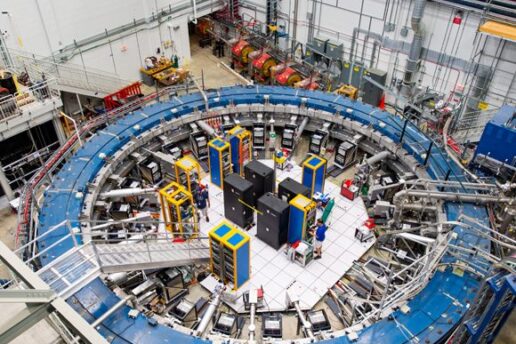
The Miraculous Measurement of the Muon
New discoveries about an elementary particle could lead to a ‘gold rush’ of new physics.
On April 7, the physics world was startled into glorious confusion by two announcements of a new measurement and a new calculation of the magnetic moment of the muon, published in the journals Physical Review Letters and Nature. The new results, accurate to the level of one part per billion, are the product of multiyear collaborations by large groups of physicists at institutions around the world. You might think that the work of making such precise measurements and calculations is as dull as science gets, but it can make magic happen.
Muons are elementary particles that in several fundamental ways resemble the more familiar electrons; for example, both carry exactly the same amount of electric charge. But there are two big differences: Muons are roughly 200 times heavier than electrons, and they are unstable, with a mean lifetime of roughly two microseconds.
As exotic particles go, muons are uncommonly user-friendly. They are easy to produce in large numbers at high energy accelerators. And though a microsecond may not sound like a long time, fast-moving muons can travel a long way before they expire, leaving easily detectable tracks. Though it’s often taken for granted, the fact that we can talk about “the” mass and “the” magnetic moment of the muon, when in practice we sample millions of different particles, is both profound and amazing. Precision measurements so far reinforce our confidence that all muons, like all electrons, have exactly the same properties.
Muons are forever rotating—as physicists say, they have “spin”—which is key to many aspects of their behavior. If a muon is exposed to a magnetic field, its rotation axis circles around that field’s direction, similarly to how the axis of a tilted, spinning top circles around the vertical. This top-like motion is called precession. The rate of a muon’s precession in a magnetic field is equal to the product of the strength of the magnetic field, some known physical constants and a number called the magnetic moment.
Making a rough prediction of the magnetic moment of a muon is child’s play (for children who’ve taken a semester of relativistic quantum field theory). But to make it accurate beyond one part in a thousand, let alone one part in a billion, you’ve got to bring in the weird quantum effect known as virtual particles. According to quantum theory, apparently empty space is actually alive with activity, as particles of all different kinds briefly fluctuate into and out of existence. These so-called virtual particles are too fleeting to register directly in practical detectors, but they modify the calculated behavior of real particles.
Many kinds of virtual particles are distributed sparsely in space. It is painstaking and intricate work to calculate their influence on the muon’s magnetic moment precisely, but after decades of practice, physicists have gotten very good at it. Other virtual particles like quarks, antiquarks and gluons are a different story. They are
dense in space and they interact strongly with one another. We are nowhere near so skillful at calculating their effects, and at present this bottleneck limits the precision of theoretical predictions.
Two different approaches to this problem are currently on the market. The older approach extrapolates from data about real particles to estimate the required information. The newer approach uses supercomputer technology to do superhuman, first-principles calculations. Those two approaches should give the same answer, but presently they don’t. The computer calculations give an answer for the muon magnetic moment that agrees with the new experimental measurement, while the data extrapolations leave a part-in-a-billion discrepancy.
A genuine discrepancy would signal that there are hitherto undiscovered particles at work. If so, other new phenomena could be right around the corner. That tantalizing possibility has triggered a gold rush of speculation and stake-claiming by physicists. Immediately after the new experimental result was announced, dozens of rival proposals materialized overnight. Physicists knew an announcement was coming, and they were prepared. But the “discrepancy” still might turn out to be fool’s gold, as the computer calculations suggest.
In any case, it’s a miracle and a blessing for physicists that we get to exercise our wits over the mere possibility of such minute discrepancies. For the deepest message of precision is that the real world of physical objects and the ideal world of mathematical constructions turn out, with mind-boggling accuracy, to be the same world.
Originally appeared on April 13, 2021 on The Wall Street Journal website as ‘The Miraculous Measurement of the Muon‘
Frank Wilczek is the Herman Feshbach Professor of Physics at MIT, winner of the 2004 Nobel Prize in Physics, and author of the books Fundamentals: Ten Keys to Reality (2021), A Beautiful Question: Finding Nature’s Deep Design (2015), and The Lightness of Being: Mass, Ether, and the Unification of Forces (2009).